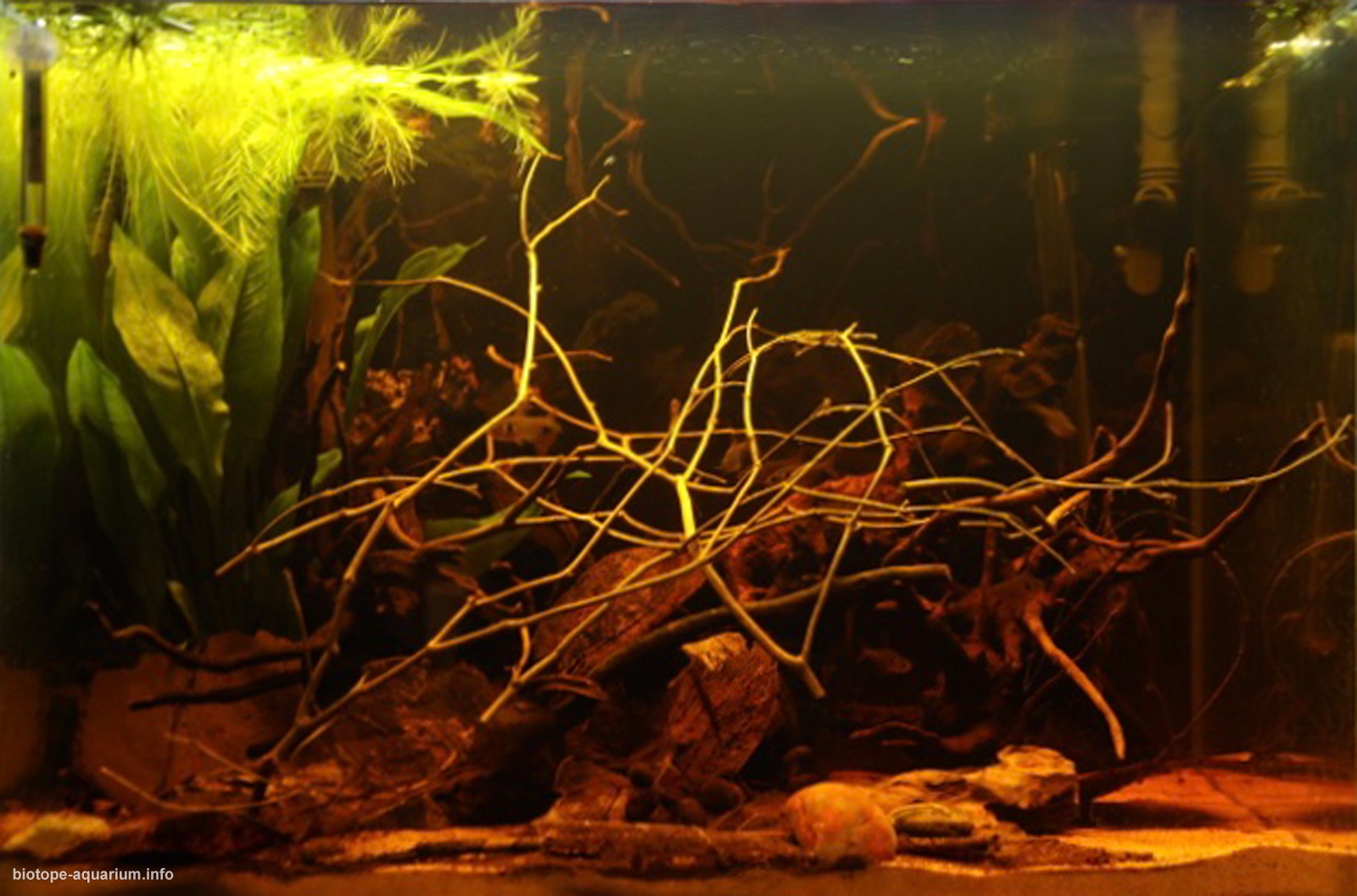Orinoco river, Colombia, South America
126th place in Biotope Aquarium Design Contest 2018
![]() United Kingdom. Piotr Sliwka
United Kingdom. Piotr Sliwka

Volume: 96 L
Dimensions: 60x40x40 cm
List of fishes: Hyphessobrycon sweglesi
List of plants: Echinodorus grisebachii, Pistia sp., Limnobium laevigatum
Description of decorations: Sand, 2 large bogwoods, few small branches, alder cones, leaves, stones.
Description of equipment: Filter: Sicce whale 120, Surface skimmer: Ocean free 150, Emi-Led: full spectrum led lamp 36W, Interpet: heater 150W.
Water parameters: Temperature: 26*C, pH 5,5, GH4.
INFORMATION ABOUT BIOTOPE
Description of the area surrounding the biotope: Flowing in a giant arc from Colombia and Venezuela all the way to the Atlantic Ocean, the Orinoco is one of the longest rivers in South America, its basin and flooded forests home to rich plant and animal life. But threats loom on the horizon for one of the most intact river systems in the world.Beginning high in the Sierra Parima Mountains of Venezuela and Brazil, the Orinoco River flows through impenetrable rainforest, flooded forests, vast grasslands and a wide delta before ending its epic journey at the Atlantic Ocean.These waters are home to the critically endangered Orinoco crocodile, river dolphins, giant river otters, the giant anaconda and more than 1,000 fish species.It is also a hub for rich birdlife, including flamingos, colourful parrots and the scarlet ibis.
Description of the underwater landscape of the biotope: The riverbed is blended repeatedly, the bottom is shaped differently, it is mostly sand, tree roots, some plants and in some areas the palm trees, quite a lot of leaves, cones, stones. In the river bend a lot of branches are falling where many fish find shelter.Water turns dark and then thins out changing the color to light.
Description of the parameters of the habitat: The water has a slightly tea color, which owes to the disintegration of plant matter and from the roots and branches.
List of fishes and invertebrates occurring in the nature biotope: Abramites hypselonotus, Acanthobunocephalus nicoi, Acestrocephalus sardina, Acestrorhynchus minimus, Acestrorhynchus nasutus, Achirus novoae, Adontosternarchus devenanzii, Adontosternarchus sachsi, Apistogramma alacrina, Apistogramma caudomaculata, Apistogramma flabellicauda, Apistogramma helkeri, Apistogramma hoignei, Apistogramma iniridae, Apistogramma inornata, Apistogramma intermedia, Apistogramma macmasteri, Apistogramma megaptera, Apistogramma minima, Apistogramma nororientalis, Belonion dibranchodon, Biotodoma wavrini, Biotoecus dicentrarchus, Boulengerella lucius, Boulengerella xyrekes, Brachyhypopomus diazi, Brachyhypopomus provenzanoi, Cetopsidium pemon, Cetopsorhamdia orinoco, Chaetostoma vasquezi, Characidium boavistae, Cichla orinocensis, Colossoma macropomum Cachama, Electrophorus electricus, Exastilithoxus fimbriatus, Farlowella oxyrryncha, Gelanoglanis stroudi, Geophagus taeniopareius, Gnathodolus bidens, Gymnorhamphichthys bogardusi, Hemigrammus elegans, Hoplias aimara, Hydrolycus wallacei, Hyphessobrycon acaciae, Hyphessobrycon albolineatum, Hyphessobrycon diancistrus, Hyphessobrycon epicharis, Hyphessobrycon mavro, Hyphessobrycon metae, Hyphessobrycon niger, Hyphessobrycon sweglesi, Hypoclinemus mentalis, Iguanodectes adujai, Imparfinis pseudonemacheir, Jupiaba scologaster, Laemolyta taeniata, Lasiancistrus tentaculatus, Leporinus brunneus, Leptodoras hasemani, Lithoxus jantjae, Markiana geayi, Megalonema orixanthum, Melanocharacidium melanopteron, Odontostilbe pulchra, Otocinclus huaorani, Otocinclus vittatus, Oxydoras sifontesi, Oxyropsis acutirostra, Pachypops fourcroi, Pachyurus gabrielensis, Pachyurus schomburgkii, Panaqolus maccus, Triportheus orinocensis, Xenagoniates bondi, Xyliphius lepturus, Xyliphius melanopterus, Zungaro zungaro.
List of plants found in the nature biotope: Helanthium tenellum, Cabomba aquatica, Echinodorus bleheri, Pistia, Limnobium laevigatum, Vallisneria, Heteranthera zosterifolia.
Sources of information:
https://en.wikipedia.org/wiki/
http://www.orinoco-delta.net/
https://link.springer.com/
